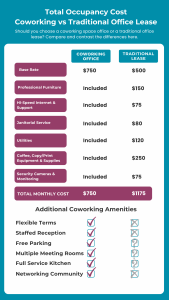
Understanding Total Cost of Occupancy: Why Coworking Is More Affordable Than You Think
At Flywheel Coworking, we often hear from potential members who are comparing the costs of coworking to traditional subleases for office space. While it’s true that coworking might appear more expensive upfront, we believe in providing a complete picture of the costs involved. That’s where the concept of Total Cost of Occupancy (TCO) comes in.
What is Total Cost of Occupancy (TCO)?
TCO is a financial metric that takes into account all the expenses associated with occupying office space, beyond just the rent. It’s a comprehensive way to understand the true cost of a workspace over a given period, often a year, and it’s a valuable tool for making informed decisions about your office space.
The Initial Cost Comparison
When comparing coworking to a traditional sublease, many people focus solely on the initial costs—such as the base rent and security deposit. At first glance, subleases may appear to be cheaper because they have lower initial rent costs. However, TCO looks beyond these initial figures.
Calculating TCO for Coworking and Sublease
To truly understand the affordability of a workspace, it’s essential to calculate the TCO for both coworking and sublease options. Let’s break it down:
For Coworking:
- Base Membership Fee

- Included Amenities (meeting rooms, utilities, cleaning, etc.)
- Transportation Savings (central location)
- Flexibility (short-term leases)
- Furniture and Equipment (often included)
For Sublease:
- Base Rent
- Operating Expenses (utilities, maintenance, property taxes)
- Furniture and Equipment (often not included)
- Transportation Costs (if the location is distant)
- Hidden Costs and Flexibility
Subleases can come with hidden costs, such as maintenance and utilities, which can add up over time. Additionally, long-term commitments in subleases may lack the flexibility needed for your evolving business. Coworking spaces often include these costs in their fees and provide short-term leases with built-in flexibility.
Transportation and Location Considerations
Think about the location of your office space. A central coworking location can reduce transportation costs for your employees and make your business more accessible to clients and partners. This convenience can significantly impact your TCO.
Using TCO as a Decision-Making Tool
We encourage our customers to use TCO as a tool for decision-making. When comparing coworking to subleases, it’s not just about cost but also about value. Coworking spaces like Flywheel Coworking offer an array of amenities, a collaborative environment, and flexibility that can be worth the investment.
At Flywheel, we believe in transparency and providing you with all the information you need to make an informed choice. While coworking may appear more expensive initially, we hope this explanation of TCO has shed light on the true cost of occupancy and the value that coworking can bring to your business.
If you have any questions or would like to discuss TCO further, please don’t hesitate to reach out. We’re here to help you find the workspace solution that best fits your needs and budget.
